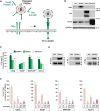Enveloped viruses disable innate immune responses in dendritic cells by direct activation of TAM receptors
- PMID: 23954153
- PMCID: PMC3779433
- DOI: 10.1016/j.chom.2013.07.005
Enveloped viruses disable innate immune responses in dendritic cells by direct activation of TAM receptors
Abstract
Upon activation by the ligands Gas6 and Protein S, Tyro3/Axl/Mer (TAM) receptor tyrosine kinases promote phagocytic clearance of apoptotic cells and downregulate immune responses initiated by Toll-like receptors and type I interferons (IFNs). Many enveloped viruses display the phospholipid phosphatidylserine on their membranes, through which they bind Gas6 and Protein S and engage TAM receptors. We find that ligand-coated viruses activate TAM receptors on dendritic cells (DCs), dampen type I IFN signaling, and thereby evade host immunity and promote infection. Upon virus challenge, TAM-deficient DCs display type I IFN responses that are elevated in comparison to wild-type cells. As a consequence, TAM-deficient DCs are relatively resistant to infection by flaviviruses and pseudotyped retroviruses, but infection can be restored with neutralizing type I IFN antibodies. Correspondingly, a TAM kinase inhibitor antagonizes the infection of wild-type DCs. Thus, TAM receptors are engaged by viruses in order to attenuate type I IFN signaling and represent potential therapeutic targets.
Copyright © 2013 Elsevier Inc. All rights reserved.
Figures






Comment in
-
Viruses PLAY DEAD to TAMe interferon responses.Cell Host Microbe. 2013 Aug 14;14(2):117-8. doi: 10.1016/j.chom.2013.07.014. Cell Host Microbe. 2013. PMID: 23954149 Free PMC article.
References
-
- Beasley DW, Li L, Suderman MT, Barrett AD. Mouse neuroinvasive phenotype of West Nile virus strains varies depending upon virus genotype. Virology. 2002;296:17–23. - PubMed
Publication types
MeSH terms
Substances
Grants and funding
LinkOut - more resources
Full Text Sources
Other Literature Sources
Research Materials
Miscellaneous

